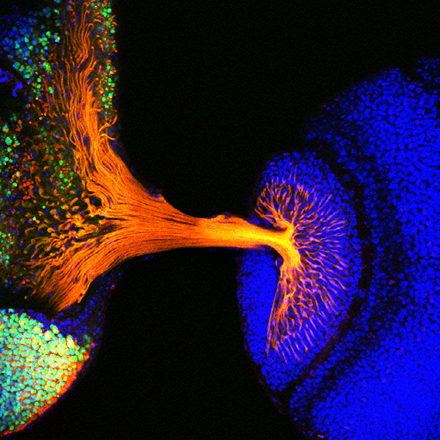

instituto de biologia molecular e celular | institute for molecular and cell biology
Previous research results:
Our work aims to uncover the contribution of core cell cycle regulators to nervous system homeostasis and function, in a postmitotic context. This is essential to uncover their impact on events leading to neurodegeneration associated with aging and disease.
We address these questions using the visual system of the fruit fly, Drosophila melanogaster, as a model. The fly visual system is a simplified neuroepithelia that shows conservation at the cellular and gene level, with the vertebrate eye, which makes it ideal to uncover mechanisms underlying neuroepithelia homeostasis. We combine genetics, with in vivo and omics approaches to gain a more comprehensive view of the neurodevelopmental processes we are studying.

IMAGE: During the larval stages, the eye imaginal disc (left) and the optic lobe (right) are connected through the optic stalk. These structures give rise to adult fly visual system. In the eye imaginal disc, the photoreceptors (green) project their axons (red) along the optic stalk and establish connections with optic lobe neurons in a highly organized manner.
Future research goals:
Our current projects address the role of cell cycle associated phosphatases in the homeostasis of postmitotic neurons. We are addressing their role in the maintenance of the differentiated cell state and in the establishment of neuronal networks. We are using a combined biochemical and genetics approach to identify their substrates in neurons and the pathways governing their expression. This will allow us to uncover novel factors with impact on nervous system homeostasis. The study of their function during normal development is aided by the analysis in fly models of neurodegeneration to expose their potential contribution to disease onset.
Selected References:
Vollmer J, Fried P, Sánchez-Aragón M, Lopes CS, Casares F, Iber D (2016) "A quantitative analysis of growth control in the Drosophila eye disc" Development 143(9):1482-90
Lopes CS*, Casares F*. (2015) “Eye selector logic for coordinated cell cycle exit.” PLoS Genet. 11(2):e1004981. (* co-corresponding author)
Pineiro C.* , Lopes CS* and Casares F. (2014) “ A conserved transcriptional network regulates lamina development in the Drosophila visual system” Development, 141(14):2838-47. (* equal contribution)
Royo JL*, Maeso I*, Irimia M*, Gao F*, Peter IS, Lopes CS, D’Aniello S, Casares F, Davidson EH, Garcia-Fernandez J and Gomez-Skarmeta JL. (2011) “Trans-phyletic conservation of developmental regulatory state in animal evolution” PNAS, 108 (34): 14186 – 14191. (* equal contribution)
Lopes CS and Casares F. (2010) “hth maintains the pool of eye progenitors and its downregulation by Dpp and Hh couples retinal fate acquisition with cell cycle exit” Dev Biology, 339(1): 78- 88.
Home | Site Map | Contacts | Credits | Privacy & Cookies | WHISTLEBLOWER CHANNEL | Intranet | Social Networks |
